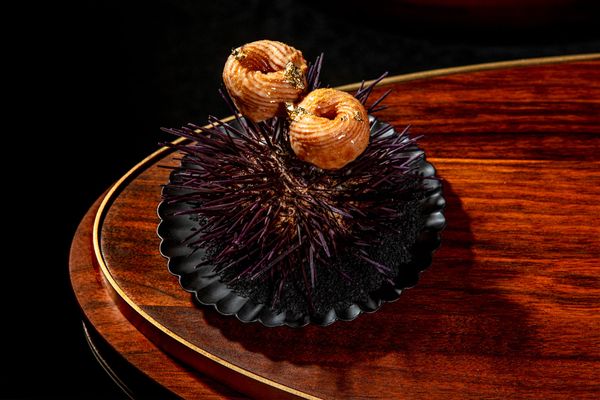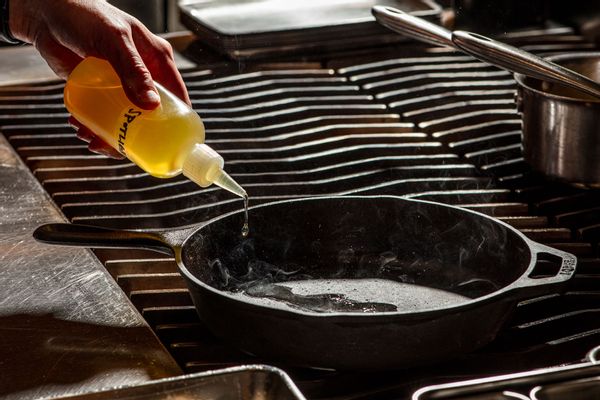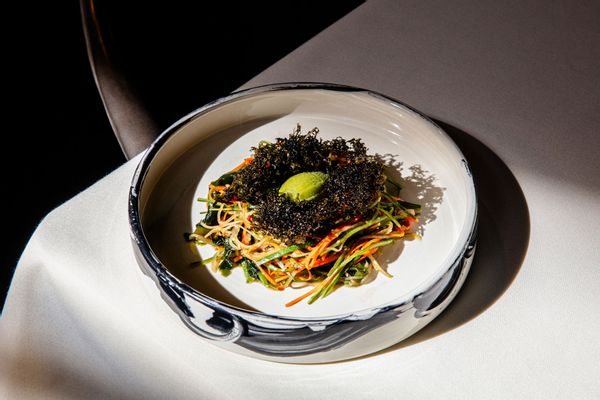“Wasteful beyond control”: A Michelin-starred chef on fine dining’s sustainability crisis
Aphotic does not provide its diners with the “happy fine dining seafood restaurant experience” one might get at Le Bernardin or oceanside at Le Petit Nice in Marseilles — at least according to Peter Hemsley, the chef behind the Michelin-starred, all-seafood restaurant in San Francisco.
The name of the restaurant, which means “without light” in Ancient Greek, makes reference to the sublayer of the ocean where light stops penetrating. “This name was chosen both for its literal take – describing the dark ocean where many of our fish come from — and also from the philosophical perspective that acts as a motivator for us,” Hemsley said. “To seek out the unknown in our oceans through dialogue, relationships, and through culinary ingenuity.”
This ethos is reflected in the design of the dark, foreboding restaurant space, with arched eves reminiscent of an upturned boat and bathrooms completely decorated with hand-picked driftwood from the short, resulting in a “moody ambience” that Hemsley says “plays into the theatrical impression that one is at the bottom of the ocean.”
But the ways in which Aphotic is distinct from other fine dining restaurants aren’t just superficial. Hemsley has focused the restaurant’s service, design and dishes towards battling food waste — a prevalent issue in an industry where 85% of unused food is thrown out.
Many would consider Hemsley a leader in nationwide sustainability efforts as Aphotic is one of only a few restaurants to be awarded a Michelin Green Star, a new designation that was launched in 2020 to recognize restaurants that uphold outstanding eco-friendly culinary practices.
 (Photo courtesy of Nicola Parisi)
(Photo courtesy of Nicola Parisi)
“Chef Peter Hemsley takes full advantage of California’s coastal bounty, sourcing exceptional seafood from small sustainable purveyors and utilizing techniques like dry aging and fermentation to maximum effect,” the Michelin Guide writes. “The kitchen’s creativity is displayed in dishes like thinly shaved Monterey abalone with swordfish ‘bacon’ and citrusy dashi broth, as well as a warm bread course paired with a curry-scented hollandaise loaded with sweet Dungeness crab.”
Hemsley isn’t convinced Aphotic is doing enough yet, saying that receiving the designation doesn’t necessarily sit well with him. “So much of our operation is wasteful beyond our control,” he said.
However, his approach to seafood is uniquely sustainable. Eighty-five percent of seafood consumed in the United States comes from international waters.
“This is due to the market demand for fresh fish, which is flying in the face of local and federal protection of our coastlines,” Hemsley said. “I chose to eschew international fish — even though the quality can be better from Japanese overnight markets that allocate the best fish in the world — because I believe it is a better way to work. “
He continued: “My desire to build a better seafood restaurant came from a legitimate frustration of being a seaboard chef and operator, and not being able to know where my fish was coming from. I made it my business to get to the bottom of this issue, met best practice fishermen along the way, and in the process became the only restaurant in the Bay Area to actively transparent lines of connection to seafood products on our menu.”
 Spotlight algae oil (Photo courtesy of Nicola Parisi)
Spotlight algae oil (Photo courtesy of Nicola Parisi)
Hemsley is also a proponent of another particular form of ocean-based sustainability, working with Spotlight, an oil derived from algae.
“When deprived of light and fed a diet of sucrose in fermentation conditions, this algal strain converts that sucrose into fat, lipids, or algal fat – oil,” he said.
Want more great food writing and recipes? Subscribe to Salon Food’s newsletter, The Bite.
The resulting oil has a higher smoke point than grapeseed oil, is immune from the farming-intensive practices of seed oils, which require tons of water and space, and carries similar health stats to plant-based oils. In addition to using Spotlight in the deep fryers , Hemsley is also “currently working on infusing the oil with dried Dulse for a seaweed driven pasta on the next menu,” adding that “this dish would sort of be a micro/macro science-driven dish with farmed seaweeds and algae oil as the highlight.”
Furthermore, even the bar team is working with “fat washes in algae oil” for cocktails.
 (Photo courtesy of Nicola Parisi)
(Photo courtesy of Nicola Parisi)
Of course, putting together (and executing) the menu of a fine dining, Michelin-starred restaurant is not a simple task. I inquired about some of the imaginative, standout menu items — like Swordfish bacon, parmesan foam, steamed crab head bun, skate cheek karaage, spot prawn mortadella, and of course the oyster ice cream, which Hemsley estimates about 5 to 10% of guests dislike “even though there is nothing wrong about it.”
“It’s thought provoking and delicious, though admittedly strange,” he said. “We could easily have opted for a fruit-based dessert starter, or the ubiquitous chocolate that everyone likes – but that would not be very true to our mission in food, nor would it be a reason to ‘make a special detour,’ the Michelin statement for a 3-star space.”
He continued: “I challenge myself and [my] team to come up with novel flavors and dishes. This is the hard work of what we are doing beyond the painstaking curation of our fishy ingredients, and managing a busy 1 Michelin starred restaurant. This is what we have earned our reputation for, and what drives people to us.”
Hemsley’s intentional, mindful directives and leadership at Aphotic can hopefully reverberate throughout the industry, with products like Spotlight and more sustainability-minded decisions being made daily in the food realm.
Read more
about this topic

